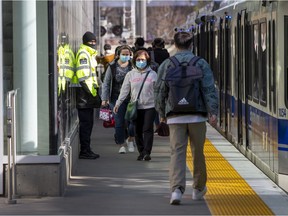'Avoid fear': Edmonton's transit safety and police response must be based on facts, says criminologist

Article content
Edmonton’s decision makers need to “avoid fear” and take an objective look at all the data as the city looks for solutions to transit safety, says a criminologist.
Violence in the LRT transit system in recent days has sparked public conversation about how the city deals with transit security and the role police play. While Edmonton police have warned of a recent increase in crime severity on public transit, data collected by the city’s transit security officers shows the number and rate of security disorder incidents have been stable or declining since early 2021.
Temitope Oriola, a University of Alberta criminologist, said these two different sets of data and the stories they tell show that the city needs to take a sober and rational look at all the evidence before it makes decisions on how to address the public’s concerns.
“When more and more citizens have perceptions of fear and their own safety, it’s important we don’t dismiss them,” he said Friday. “But it’s also essential that we get at the heart of the issue with empirically verifiable stats and facts, and as much as possible, we avoid fear communication.”
Crime severity on LRT
Data released during an Edmonton police commission meeting last month showed crime on the LRT system grew in severity from February of 2021 to the end of the year, at a faster rate than the city’s overall severe-crime trend.
The severity rate rose and fell at various points between January 2020 and December 2021, and the worst months in 2021 were in October and December.
But looking at the number of social disorder incidents tells a different story.
Numbers from Edmonton Transit Service (ETS) obtained by Criminal Trial Lawyers Association (CTLA) this week, and validated by Postmedia, show the rate of incidents reported by transit security per 100,000 trips has generally been dropping since last spring.
Chris Wiebe, spokesman for CTLA, acknowledges that there have been violent incidents on transit recently. Last month, a 78-year-old woman was pushed onto the LRT tracks.
But given the stability of the ETS disorder figures — which don’t include incident type or severity — he thinks the city needs more information before increasing the police budget or changing bylaws.
Wiebe said the president of the Edmonton Police Association, Michael Elliott, has been posting frequently on social media about problems with transit since the police budget turned out to be lower than expected. He’s concerned police will use transit safety fears to leverage a budget increase for 2023.
“Elliott began tweeting frequently about transit disorder, including some pretty disturbing pictures, tweets that give the impression that he intends to stoke fear,” Wiebe said. “When people are afraid of crime and disorder they are more likely to want elected officials to invest in policing. We hope this data causes people and council to reconsider that instinct.”
Wiebe worries reinstating the loitering bylaw could lead to discrimination of more vulnerable Edmontonians and racialized minorities as that gave police wider permission to intervene than the inappropriate behaviour bylaw that replaced it.
Responding to CTLA’s comments, president of the Edmonton Police Association Michael Elliott, said the issue of transit safety has been identified and reported on by every major news outlet in Edmonton.
“You’re either complimenting my ability to influence the narrative so effectively that even mainstream media cannot decipher it as ‘baseless’ or perhaps — there is a legitimate public safety concern that needs to be addressed,” he wrote in a text message to Postmedia.
If police are framing the transit safety issue in a particular way to get more funding, it wouldn’t be the first time, Oriola said.
“Police organizations, in particular, have a track record across various jurisdictions, not just in Edmonton, of releasing numbers at specific kinds of moments in order to sway elected leaders in order to give them more funds,” he said.
“The onus is on the city council to dig deeper and ask tough questions. Whatever decision they choose to make has to be driven by science and a vision of public safety.”
Oriola and Wiebe say the city needs to look at social agencies to address the root causes of homelessness, drug use, and mental health concerns instead of relying solely on the police.
EPS spokeswoman Carolin Maran said police have a role to play in transit safety.
“Concerns regarding transit safety have become part of a community-wide conversation that is not limited to police, and these concerns remain part of a broader community safety issue that the EPS will work with its partners to address,” Maran said.
Editor’s note: This story has been updated to include comments from Michael Elliott.






Postmedia is committed to maintaining a lively but civil forum for discussion. Please keep comments relevant and respectful. Comments may take up to an hour to appear on the site. You will receive an email if there is a reply to your comment, an update to a thread you follow or if a user you follow comments. Visit our Community Guidelines for more information.